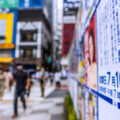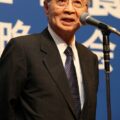Solidarity in the wake of the Great Hanshin-Awaji and Great East Japan Earthquakes
Iokibe Makoto, President of the Hyogo Earthquake Memorial 21st Century Research
Institute, former Chairman of the Reconstruction Design Council following the Great
East Japan Earthquake
――It’s been 10 years since the Great East Japan Earthquake. You served as chairman of the Reconstruction Design Council following the Great East Japan Earthquake.
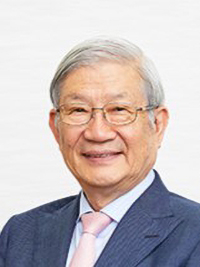
Iokibe Makoto, President of the Hyogo Earthquake Memorial 21st Century Research Institute
Iokibe Makoto: I guess I was nominated as Chairman of the Reconstruction Design Council because of my experience from the Great Hanshin-Awaji Earthquake in 1995, which marked a major turning point in Japan’s disaster response and reconstruction policy approach. At the same time, I was also a victim myself. My house in Nishinomiya City, Hyogo Prefecture was completely destroyed, and, at Kobe University where I worked, 39 students, including my seminar student, and two members of staff lost their lives. All in all, the earthquake caused the deaths of 6,343 people.
Having unexpectedly become a victim myself, I was shocked by two things. First, I was overwhelmed that even Japan, a developed country, was so fragile and experienced such a breakdown in society following an earthquake directly beneath a land area. Japan is said to be a country of frequent earthquakes and yet this was the first earthquake for almost half a century—since the Fukui Earthquake in 1948. We had let our guard down and been caught unawares. The physical damage was devastating.
Rejection of creative reconstruction following the Great Hanshin-Awaji Earthquake
Iokibe: Another thing that shocked me was the gap in understanding between local and central governments which I sensed in the reconstruction process. Hyogo Governor Kaihara Toshitami had been exploring a new society or civilization for the 21st century prior to the earthquake and, therefore, wanted to use the disaster as an opportunity for “creative reconstruction” suited to a mature society in the 21st century as opposed to mere recovery. This approach is now the international standard as advocated in the “Build Back Better” strategy described at the UN World Conference on Disaster Risk Reduction held in Sendai City, Miyagi Prefecture in 2015. However, this was not the approach in Japan at the time.
In February 1995, at the first meeting of the “Great Hanshin-Awaji Earthquake Rehabilitation Committee,” established as the Prime Minister’s consultative body, special advisor Gotoda Masaharu, the former Deputy Prime Minister, stated that “Getting richer after a fire won’t be tolerated” and set out two principles for the reconstruction of Hyogo. The first was not to spend public funds on creative reconstruction. Central government would take care of the “recovery” of affected areas, in other words, putting them back to their original state, but creative recovery to build something better than before the disaster should be funded by local governments. The second principle was the private property self-responsibility theory, in other words, not spending public funds on rebuilding the private properties or homes of victims. Individuals were responsible for rebuilding private properties themselves and spending public funds on this was dismissed as inconsistent with the legal system.
These two principles, dubbed the “Gotoda doctrine,” became “obstacles” to the reconstruction of affected areas. Self-responsibility theory was advocated not only by Gotoda but also by central government bureaucracy and neighboring local authorities at that time and opposition to active fiscal stimulus could be heard. As a victim myself, I felt somehow cast adrift by central government and was bitterly disappointed.
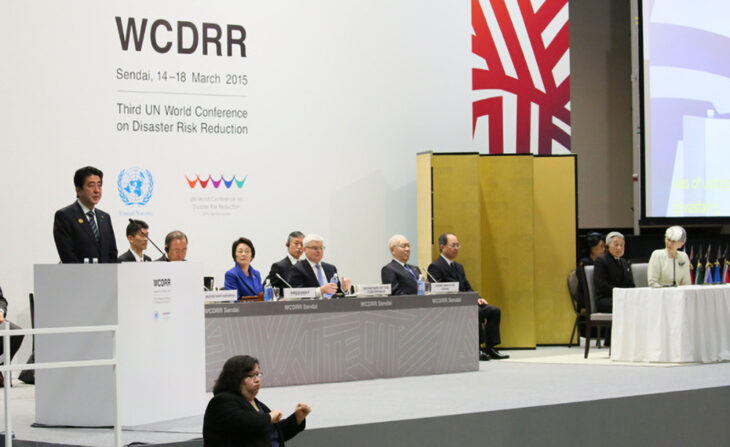
On March 14, 2015, then Prime Minister Abe Shinzo said “Japan is working on the reconstruction from the Great East Japan Earthquake based on the idea of ‘Build Back Better,’ which aims not simply to recover the same situation that existed prior to the disaster, but rather build a society that is more resilient to disasters than before” at the High Level Segment of the Third UN World Conference on Disaster Risk Reduction held in Sendai City, Miyagi Prefecture.
Photo: Cabinet Public Relations Office
――This prompted calls for legislation to help victims rebuild their lives.
Iokibe: Three months after the earthquake, the Hyogo prefectural government and Kobe City decided to create a 600 billion yen reconstruction fund through the issuance of local government bonds (in a ratio of 2:1) and to meet the reconstruction demand not recognized by central government through investment at a rate of 4.5% over 10 years. At the same time, the Hyogo prefectural government continued to call on central government to set up a benefit system to help victims rebuild their lives and, as a result, the “Natural Disaster Victims Relief Law” was established as lawmaker-initiated legislation in 1998. Under the law, natural disaster victims received up to 1 million yen (since revised to up to 3 million yen) for the recovery of private properties. Leaving the sum aside, the discarding of the theory of self-responsibility for private property was undoubtedly groundbreaking in terms of reconstruction support in Japan.
――By way of contrast to the coldness of central government, 1995 was called the “first year of the (disaster) volunteer” and many citizens were involved in supporting victims.
Iokibe: As you point out, as many as 1.3 million volunteers donned their rucksacks and traveled to the affected areas from all over Japan. A Confucian society, which is the type of society Japanese people had grown used to, operates on the principle that public matters are taken care of by bureaucrats and private citizens mind their own business. However, the volunteers back then had a fervor and presence which instantly swept away this principle. In face of this new-found solidarity, unimaginable before, we were grateful that we were not alone and that people from all over Japan were supporting us.
The social impact of this was huge and the Law Concerning the Promotion of Specific Non-Profit Organization Activities (so-called NPO Law) was enacted in 1998 to acknowledge and encourage citizens’ participation in various public activities. Strangely, 1998 was also the year when the Natural Disaster Relief Law came into effect, and I believe that simultaneous acknowledgement of citizens’ key role in the public sector (NPO Law) and confirmation of citizens’ entitlement to public support from the state (Relief Law) is indicative of the spirit of the times towards disaster recovery.
This experience of “solidarity” is one of my drivers. When I became Chairman of the Reconstruction Design Council following the Great East Japan Earthquake, I thought now is the time to repay the kindness I received as a victim.
Shift towards creative reconstruction following the Great East Japan Earthquake
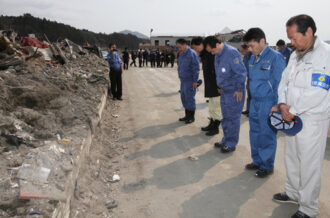 On April 2 in 2011, then Prime Minister Kan Naoto (third from the right) visited Rikuzentakata City, Iwate Prefecture |
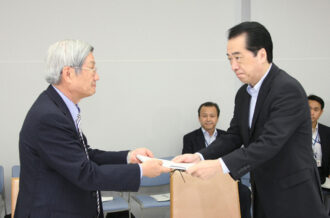 Iokibe Makoto, Chairman of the Reconstruction Design Council handed the report to then PM Kan on June 25, 2011 |
| Both photos: Cabinet Public Relations Office |
――As you just said, you became Chairman of the Reconstruction Design Council. What points did you consider when putting together the reconstruction plan?
Iokibe: The Reconstruction Design Council held intensive discussions for two-and-a-half months starting from April 11, 2011, one month after the disaster, and reported to then Prime Minister Kan Naoto on June 25 [Towards Reconstruction—“Hope beyond the Disaster”]. With “disaster reduction” as the concept, the new policy for the Pacific coast of Tohoku, the area most badly affected by the tsunami, aimed to create safer cities, towns and villages through a combination of strategies including relocation of victims to higher ground, tsunami breakwaters[1], coastal dikes[2] and setback levees[3], memorial forests and raising land. The new policy also included calls for creative reconstruction rather than mere recovery, with group subsidies[4] and other funds to be used for purposes such as revitalization of commerce, fisheries and agriculture, integrated care for the elderly and renewable energy facilities. This was the first time in the history of Japanese disasters that a Reconstruction Plan had been proposed and publicized in advance.
――What was the government response to creative reconstruction?
Iokibe: Since Prime Minister Kan’s cabinet had approved “creative reconstruction” ahead of the establishment of the Reconstruction Design Council, this spared us the trouble of discussing the rights or wrongs of the policy. The next important point of contention was, of course, funding the reconstruction.
――The debate about raising taxes to fund reconstruction quickly became the focal point.
Iokibe: From the outset, I mentioned reconstruction tax as part of the basic policy in my capacity as chairman, thinking that Japan, which had already racked up debt of 200% of GDP, should not rack up further debt to be borne by future generations and that our generation alive in the same era ought to support the reconstruction of affected areas. But since I announced the policy prior to discussions at the Reconstruction Design Council, the idea was shot down by arrows of criticism from all directions. Even in the council, my argument for raising tax came in for harsh criticism.
However, any discussion of the specific details of construction measures must surely entail asking how much funding is necessary and how to raise the funds necessary and whether any shortfall in contingency funds would be filled with borrowing or a reconstruction tax. Sure enough, when the extensive reconstruction details came up for discussion in the Reconstruction Design Council, both the council members and the public were in a mood to accept new taxes. Consequently, in November 2011, the governing party and the two opposition parties all approved introduction of a reconstruction tax, primarily a 2.1 percent surtax on income tax.
I still remember today when we invited Mr. Kaihara, who had retired as Hyogo Governor, to the 3rd Reconstruction Design Council held at the end of April in the early days of the debate about raising taxes. At the meeting, he grilled the committee members, saying that “a reconstruction plan without funding is pointless.” Whilst this was an earnest plea based on his experience of reconstruction following the Great Hanshin-Awaji Earthquake, it also sounded as though I had urged him to say it.
On this island so frequently hit by earthquakes, it is not strange for any region to be affected next. Wherever that may be, the Japanese people come together as one community and share the pain. I think it is fair to say that this kind of phenomenon emerged with the Great East Japan Earthquake.
――Another challenge is the question of the financial burden on local governments.
Iokibe: Back then, Japan had a system under which central government subsidized three quarters of the cost of disaster reconstruction measures such as relocation to higher ground and the remaining quarter was borne by local governments. However, for municipal local governments outside of Tokyo, one quarter of the cost was still by no means a small burden.
Back in 2011, the unpaid balance of prefectural loans issued by Hyogo Prefecture for recovery and reconstruction related projects following the Great Hanshin-Awaji Earthquake of 1995 amounted to around 570 billion yen. The outstanding balance still stands at 340 billion yen in 2021 and is expected to take a further 10 years to be paid off. Considering that even Hyogo Prefecture, an industrial powerhouse, is struggling with loan repayments to this extent, local authorities in the Tohoku region, which are financially weaker, would be in trouble if they took the same path. I had asked the staff of the Reconstruction Design Council Secretariat whether a scheme under which central government subsidizes 90–95% of the reconstruction funds would be possible but the ruling Democratic Party and the opposition Liberal Democratic Party and Komeito agreed to appropriate reconstruction tax as reconstruction funds, and a reconstruction scheme under which central government subsidizes 100% of the reconstruction costs was introduced.
I was somewhat concerned about this. I was glad that the financial burden on affected areas would be small. However, no burden at all will likely lead to moral hazard. Local governments run the risk of getting hooked on excessive budgets. “Surely local governments would spend the budget more sensibly if they bore even 1% or 0.1% of the cost?” Without thinking, I asked the staff who came to tell me of the government’s decision this same question. However, the central government’s reconstruction budget following the Great East Japan Earthquake amounted to around 3.2 trillion yen over 10 years, which was around three times the budget of just under 10 trillion yen following the Great Hanshin-Awaji Earthquake. Even a burden of 1% would put a strain on local governments. It is difficult to judge the scale of reconstruction that is appropriate.
Sharing Japan’s experience and skills with the world
――The reconstruction scheme created at the time of the Great East Japan Earthquake has also been used since.
Iokibe: The scheme was also adhered to following the 2016 Kumamoto earthquakes. Group subsidies were also used for the reconstruction of local shopping malls affected by the Kumamoto earthquakes and for projects such as Aso Volcano Museum which I was involved in.
Following the Kumamoto earthquakes, there was also push-type support from central government. It was the Union of Kansai Governments which first focused on push-type support following the Great East Japan Earthquake. Based on their experience of the Great Hanshin-Awaji Earthquake, the Union of Kansai Governments first unilaterally sent supplies considered necessary in the wake of the disaster. This is not a time to ask the affected areas, which have been thrown into chaos, to list up the items they want. First, it’s up to us on the outside to move. Then, accompanying personnel stayed in the affected area to grasp the supplies and services needed on the ground and translated this into continuous support. This push-type support allowed an efficient support system to be put in place without badgering those in charge in the areas in the midst of the chaos caused by an earthquake. Following the Kumamoto earthquakes, the Japanese Government did this for us. Also following the flooding of the Kumagawa River (southern area of Kumamoto Prefecture) in 2020, the Japanese Government provided push-type support, sending cardboard to enable partitioning within evacuation centers in response to the COVID-19 pandemic.
――International cooperation for disaster prevention/reconstruction is also important.
Iokibe: The disaster response experience and skills developed by Japan to date is being used not only in Japan but also in international disaster reconstruction support efforts, and Japan must continue to disseminate such experience and skills as common property in the future. The “Hyogo Earthquake Memorial 21st Century Research Institute,” a comprehensive disaster prevention think tank of which I am President, serves as a global intellectual hub specializing in disasters.
The establishment of this think tank was one of the ideas included in Hyogo Prefecture’s creative reconstruction plan described earlier. The inspiration came from the late Shimokobe Atsushi who served as chairman of the Committee for Reconstruction of the Hanshin-Awaji Area. In contrast to the cold stance towards affected areas observed in some quarters of government, Shimokobe had personally shown support for Hyogo’s creative reconstruction. He knew that Hyogo Prefecture had been far more passionate about urban development than other prefectures in Japan and had been very encouraging, saying that Hyogo should go ahead since it already had a vision. One of Shimokobe’s pet projects was to create a global intellectual hub in Kobe City like the Smithsonian Institution in Washington DC. The embodiment of this idea is this belt of coastal research institutes.
We have sent researchers not only to natural disasters in Japan but also to earthquakes that have occurred in Turkey and Chile. The objective is to make our knowledge and experience available to those on the ground and also to carry out fresh investigations into natural disasters and gather data. As President, I am proud that young researchers who have been trained here are working on the frontline around the world as experts in disaster prevention and reconstruction.
It is also truly significant that a think tank charged with such a mission is located in Kobe City. Because the people here still have a strong drive to do their best to keep on living for all those who lost their lives in the earthquake and to build a disaster-resilient society, and I am, of course, one of them.
Interviewed by Nakamura Kiichiro, editor-in-chief, Gaiko (Diplomacy)
Translated from “Hanshin-Awaji kara Higashi Nihon Daishinsai e ‘rentai’ no shiso wo tsumugu (Solidarity in the wake of the Great Hanshin-Awaji and the Great East Japan Earthquakes),” Gaiko (Diplomacy), Vol. 66 Mar./Apr. 2021 pp. 6-11. (Courtesy of Toshi Shuppan) [August 2022]
Keywords
- Iokibe Makoto
- Hyogo Earthquake Memorial 21st Century Research Institute
- Great Hanshin-Awaji Earthquake
- Great East Japan Earthquake
- Reconstruction Design Council
- creative reconstruction
- Hyogo Prefecture
- Kaihara Toshitami
- Build Back Better
- Natural Disaster Victims Relief Law
- volunteers
- NPO Law
- Relief Law
- taxes
- financial burden
- local governments
- Kumamoto earthquakes
- Shimokobe Atsushi
- Committee for Reconstruction of the Hanshin-Awaji Area
